Wayanad has always granted me countless memories, many of them from the time spent watching birds. But the memory lane of my tryst with the Legge’s Hawk Eagle stands out the most: not because of the bird itself, but because of how the entire four-month journey unfolded, involving the people, the wildlife, and the successful completion of my master’s field work in the backdrop 😊.
Not long into my field work in Wayanad, Mathannan -Mathan Pilakkavu, my field collaborator and childhood bird watching companion belonging to the Urali tribal community- and I were looking out for bird flocks on a transect close to my house. I was very familiar with this route and was not wary of elephants, which only seemed to appear when we started recording flocks. This time, however, an unusual call caught my attention. It distracted me while Mathannan was pointing the microphone towards the cacophony of birds. The unfamiliarity of the call gnawed at me, and I struggled to hold back the urge to locate its source. I gestured and handed over the recording task to Mathannan and scurried into the undergrowth towards the call. It turned out to be a pair of Legge’s hawk eagle, calling incessantly as they moved in short flights from tree to tree. Mathannan managed to record their calls, and we sped back home to share the exciting news with my father, who was recovering from Covid at that time. My father, Manoj Kumar A V, has been a guiding light, and an inspiration – the finest naturalist I have known. I couldn’t have asked for a better mentor and a friend in my life.
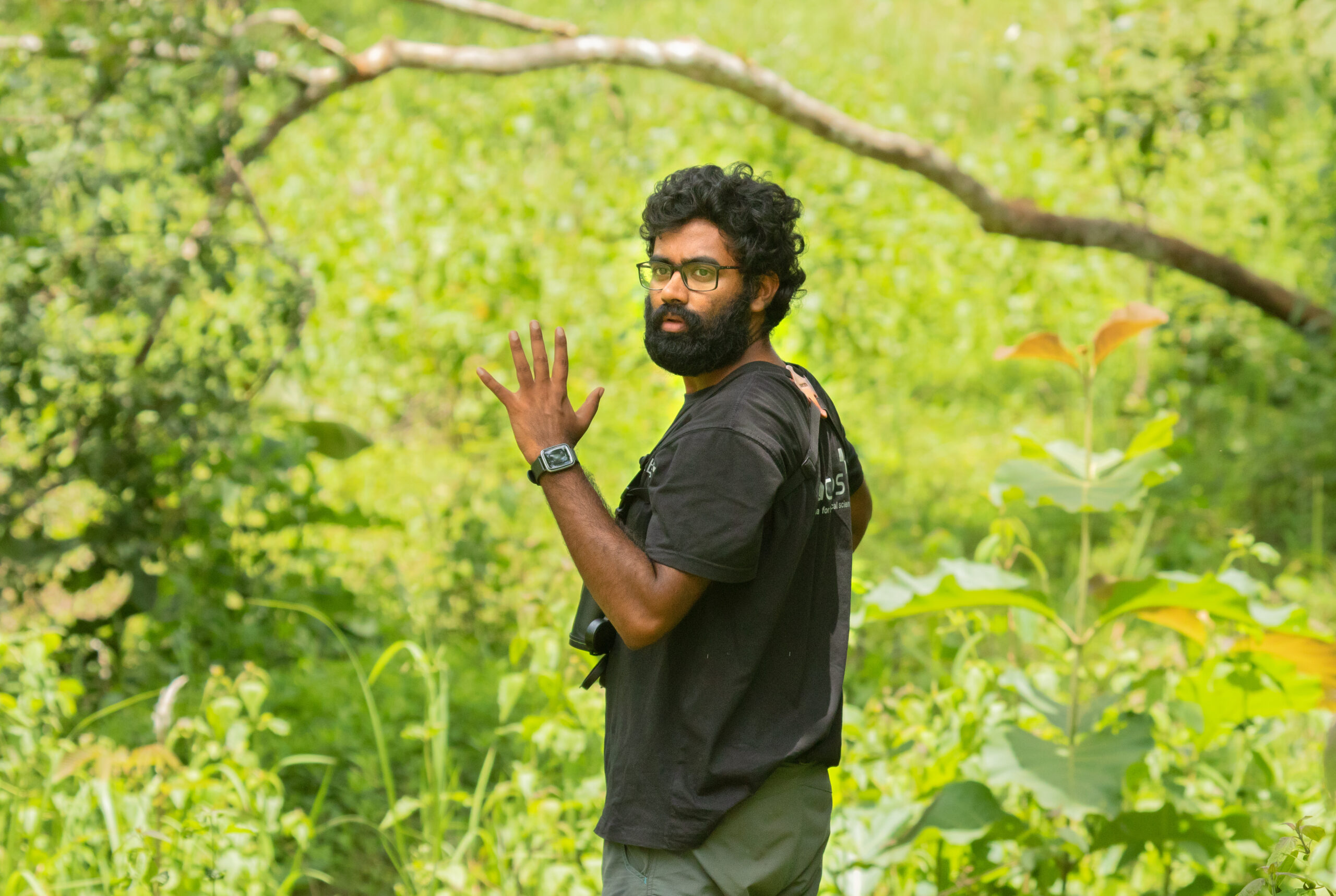 Me, attempting to convey information to Mathannan through hand gestures while collecting data on mixed-species bird flocks. ©Manoj Kumar A V
Me, attempting to convey information to Mathannan through hand gestures while collecting data on mixed-species bird flocks. ©Manoj Kumar A V
Our first thought was: Could this courtship behaviour mean that the birds are nesting nearby? Restless with curiosity but bound indoors by his recovery, my father encouraged me to investigate further. Inspired by his determination, I scrambled back to the location, determined to unravel the mystery. After a few hours of following the calls, and meticulously scanning tree forks, my eyes caught hold of something I remember to this day. It was the crest of an adult hawk eagle swaying with the wind! The bird was trying to conceal itself by burying into the nest, trying to evade my gaze.
Overcome with excitement, I rushed home to describe the sight in vivid detail. As I narrated, doubt crept in, prompting me to return with a pair of binoculars to confirm the bird’s identity. And there it was—a nesting Legge’s hawk eagle! The next four months of documenting this discovery remain one of the most rewarding experiences of my life. The detailed chronicle of this journey is published in Indian Birds.
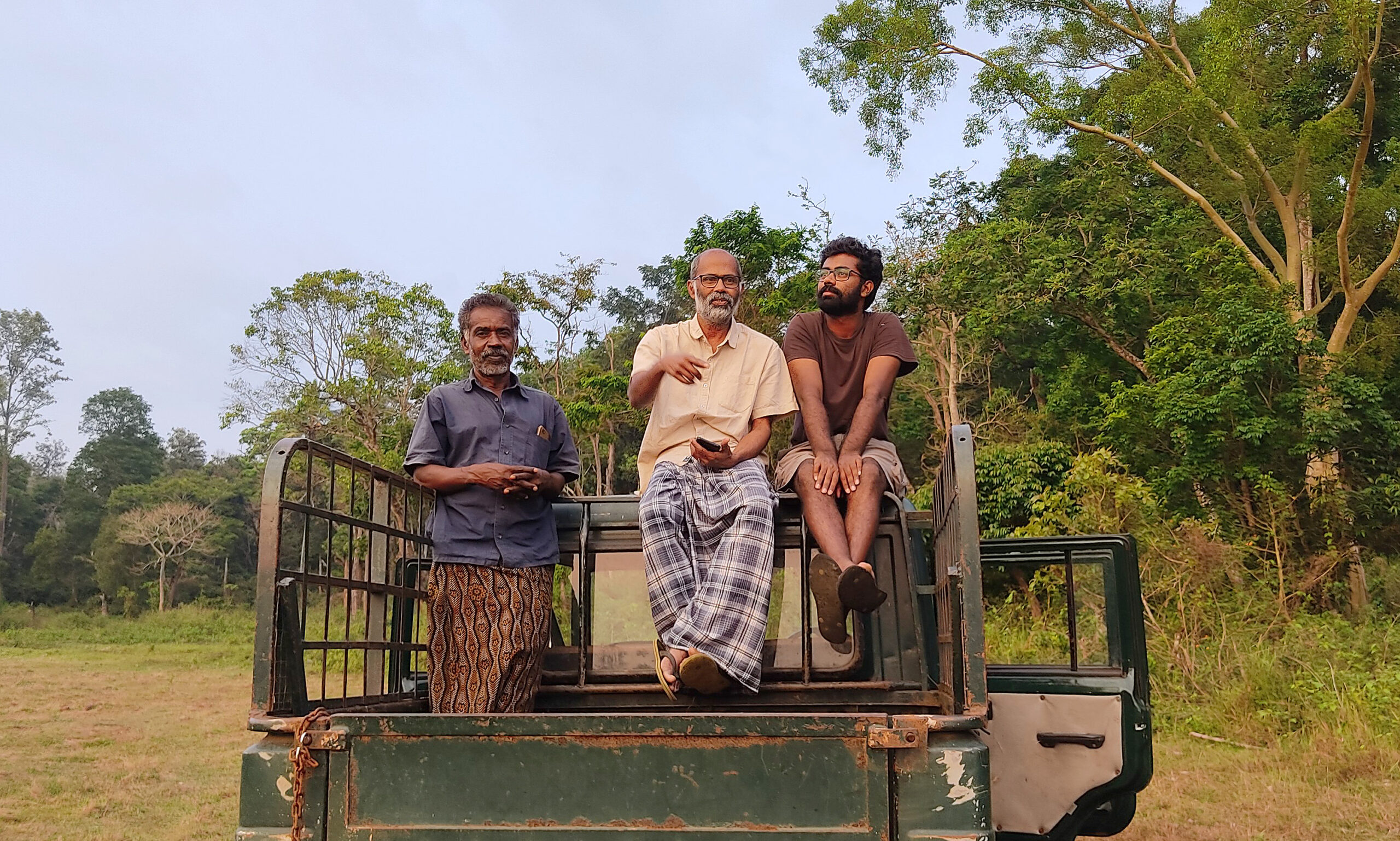 From left to right: Mathan Pilakkavu (Mathannan), Manoj Kumar A. V. (Father), and me, having a casual conversation after building the blind to observe the Legge’s Hawk Eagle.
From left to right: Mathan Pilakkavu (Mathannan), Manoj Kumar A. V. (Father), and me, having a casual conversation after building the blind to observe the Legge’s Hawk Eagle.
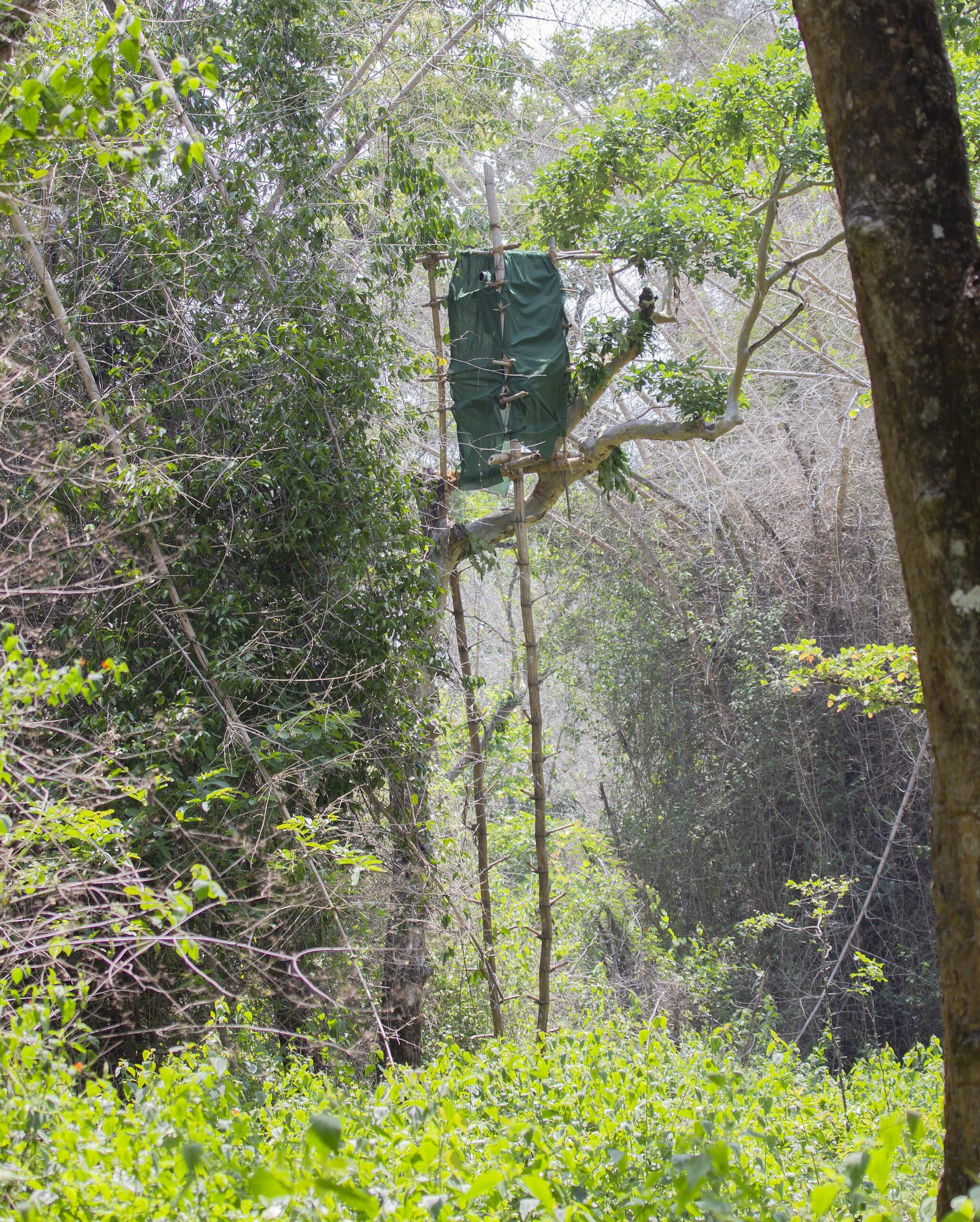 One of the many bird blinds we had constructed over the years.
One of the many bird blinds we had constructed over the years.
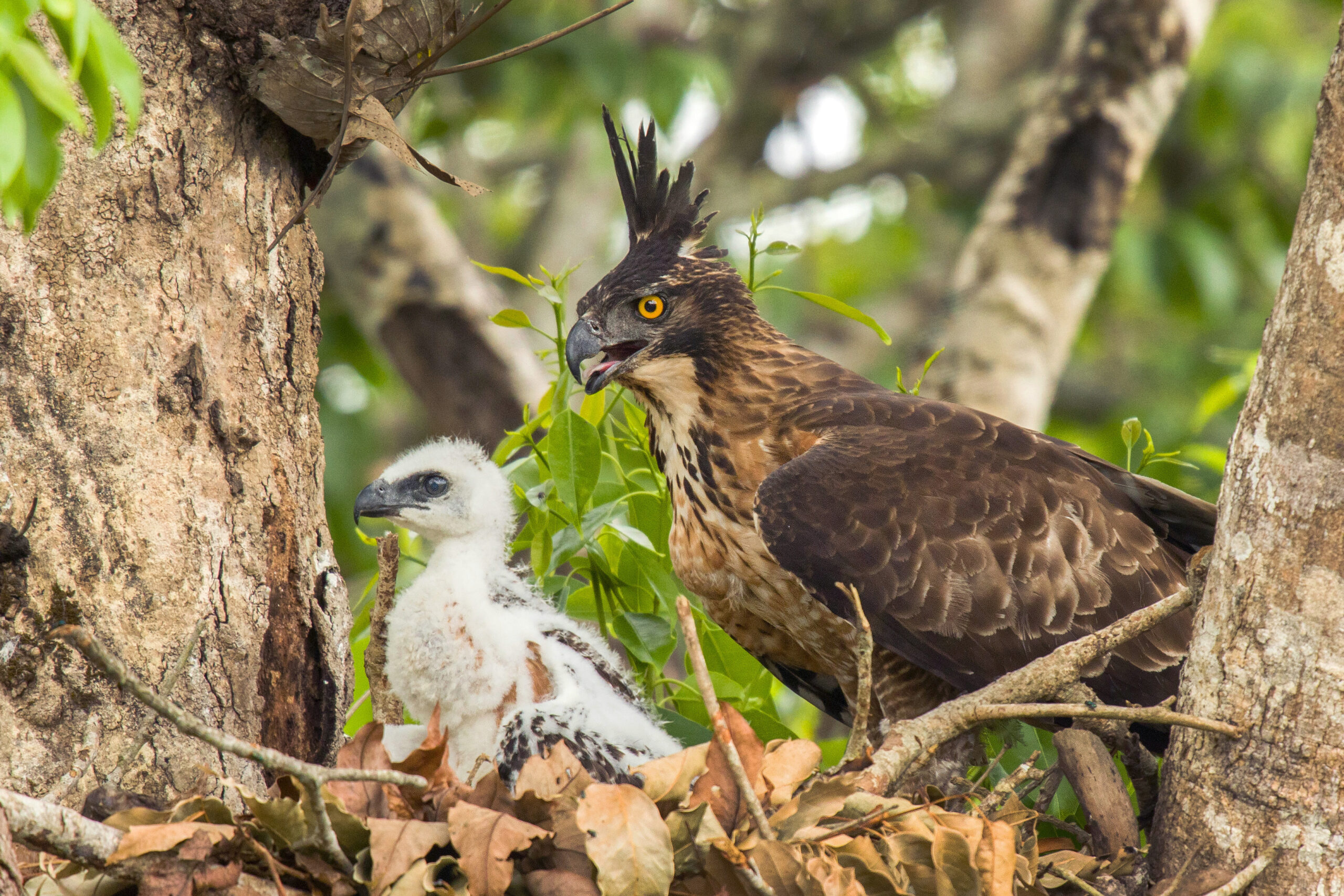 The female Legge’s Hawk Eagle parent guarding the chick. ©Abhijith A V
The female Legge’s Hawk Eagle parent guarding the chick. ©Abhijith A V
This is how my love and interest in birds took shape..
I grew up in Wayanad, a mesmerizing landscape teeming with wildlife and a complex social fabric. My obsession with observing nature came naturally to me when this setting was complimented by my mother’s (Sherly Prasannan) support and father’s mentoring. He is not an ornithologist by training, but an ardent observer, documenting nature in its most crude form: simple natural history observations.
As a result, we did not adhere to any prescribed methods for observing birds. For us, binoculars and a notepad were not essentials, nor did we set aside specific time for nature watching. Instead, it was a passive, yet an ever-present hobby that occupied our minds no matter what tasks we were engaged in. We share countless memories of being simultaneously jolted by a bird’s call or a rustle of leaves, while others in the room looked on in confusion, wondering what had distracted us. Our standard practice involves carefully building a bird blind near a nesting or feeding site and waiting patiently for the birds or other animals to come closer. Once they settle down and grow accustomed to the new setup, it is an absolute pleasure to observe them up close, exhibiting behaviors that often escape notice when they are aware of human presence.
My father’s close association with the grassroot-level conservation organization, Wayanad Prakriti Samrakshana Samiti, and their activities meant that I was drawn to their work early in life. These experiences enabled me to connect and interact with different sections of Wayanad’s society and exchange ideas, shaping my understanding of wildlife conservation. Only later, while archiving physical materials related to the landscape’s ecological history, did I realize the profound impact these activities had in shaping it.
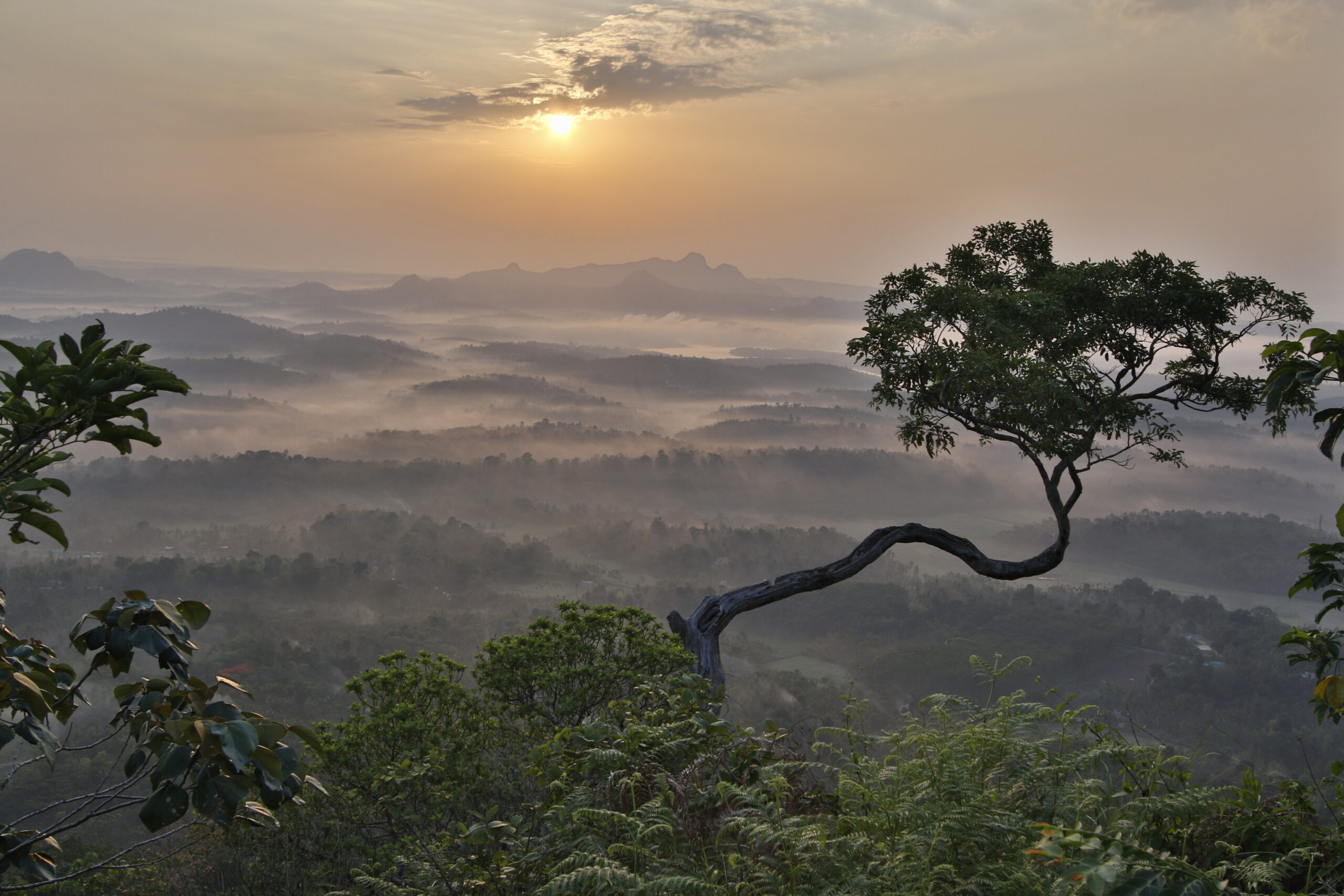 The morning view from one of my regular birding trails. ©Abhijith A V
The morning view from one of my regular birding trails. ©Abhijith A V
It is quite difficult to identify when these interests transitioned to formal research. I call it formal because research is traditionally considered an academic venture, often disregarding experiential knowledge system, like the one shared between my father and me. Unaware of this distinction, I decided to quit academia after my 12th standard, determined to follow my passion for agriculture and nature watching. However, it only took me a year to realize that having an academic affiliation greatly influences how people perceive and value my ideas. At this juncture, I decided to return to academia and focus on scientific research.
I completed my bachelor’s in Biology with honors from Azim Premji University and later graduated from the Wildlife Biology and Conservation program at NCBS. Currently, I am pursuing my PhD with Dr. Anand Krishnan at JNCASR. During my bachelors, under the guidance of Dr. Shomen Mukherjee, I worked in coffee farms in Wayanad, exploring possible mechanisms of co-existence among sympatric and closely related bush frog species. For my master’s dissertation, I worked with Dr. Priti Bangal, Dr. Samira Agnihotri, and Dr. Anand Krishnan, examining the relationship between the morphological and acoustic trait spaces of mixed species bird flock participants, in Wayanad. Presently, I am studying the breeding ecology and nesting behavior of birds in Wayanad. By now, it must be apparent that Wayanad has always been my field, partly because of my love for the landscape. And I would like to keep it that way.
I love what I do because…
Fieldwork is one of the most enjoyable aspects of my work. I consider it a privilege and an honor to claim that I research wildlife for a living. It provides me with an opportunity to reconnect with the landscape and its people. Most importantly, it allows me to truly be myself.
I cherish the evenings after a long day of fieldwork, sitting alone in a quiet corner, sipping a cup of black coffee, and soaking in the sounds of roosting birds gradually giving way to the mysteries of the nocturnal world. Experiencing the nightlife transition into morning bird choruses is equally mesmerizing. Another aspect of my work involves analyzing the data meticulously collected during the field season. Watching the raw data take shape on the computer screen is undoubtedly a gratifying experience. However, this is secondary to the thrill of reminiscing about past field seasons and the anticipation of the adventures yet to come.
 A snapshot of the mesmerizing habitat I hail from 😊 ©Abhijith A V
A snapshot of the mesmerizing habitat I hail from 😊 ©Abhijith A V
Challenges I have faced..
Once I decided to continue academics after my brief sabbatical after 12th, I was certain that wildlife biology was the field I wanted to pursue. However, I was skeptical about building a research career focused on birds, fearing it might take away the pure joy of birdwatching. While the idea of earning a livelihood by observing and studying birds was undeniably appealing, I worried that the stress of academia, with its intense focus on publishing, might diminish the joy I had nurtured over the years. This remains a challenge to date.
Before starting my bachelor’s degree, I devoted considerable time outside academic hours to conducting birdwatching sessions, organizing classes, and hosting bird photography exhibitions, especially for school students. I believed birdwatching was an ideal gateway for students to develop a deep connection with their natural surroundings. My hope was that this love for nature would evolve into a commitment to conservation.
However, with the advent of the internet and the increasing accessibility of mobile devices, I have observed a noticeable decline in students’ enthusiasm and motivation. Often, their interest lies more in the technical aspects of bird photography than in the subjects themselves. I am still navigating this challenge and experimenting with different teaching tools to rekindle their curiosity and passion for the natural world.
My advice to young researchers is..
I don’t feel I have enough experience to offer advice to young researchers, but I’d like to share a few thoughts:
- There is no prescribed way to watch birds. Everyone develops their own personalized approach, and the journey of discovering one’s unique way of observing nature has its own charm.
- I feel that much of the current literature on birds is losing its connection to natural history. Personally, I’m a strong advocate of beginning any line of inquiry with pure observations and then building on that foundation.
- No one is truly an all-knowing expert. Nature is incredibly complex and diverse, and it’s important not to blindly accept what an authority in a particular field claim. Take everything with a pinch of salt and tie it to your own conceptualization before internalizing any information.
Abhijith A V
Email: [email protected]
PhD Student, ECEB Lab,
Evolutionary and Organismal Biology Unit (EOBU), JNCASR
Research gate profile
Instagram account
Facebook page

How exciting and beutiful. My best wishes for much more in the future.
The seamless convergence of photography, birding, research, and social processes into a unified vision of long-term conservation is truly inspiring. It’s a reminder that when passion meets purpose, the impact resonates far beyond the moment. Keep leading by example!
.
Nammikkunnu
Always have been a great admirer of your tenacity that always tends to trickled down into those wonderful photographs that you capture. Having known your dad’s and your work I really need to mention that maybe there is still a lot that is actually there to look forward to in spite of all the development that is happening in Wayanad. Very inspiring.
Wow!!! And I shall write the books for little kids to familiarise them with Nature and come to love it.
Hi Abhijith…congratulations for your great eco conservation research activities
& nice bird photography etc.
In the very outset let me congratulate Abhijith for the paper presented in his field of study. Hats off to his dedication and commitment. The language used is humble and simple. I appreciate that. Somewhere he mentioned “I love what I do…”. If one can love the reality he/she builds then nothing can stop him/her. No doubt many many recognitions are waiting for his work. Very nice and happy to read his meaningful advice to the upcoming young researchers. Abhijith will be the role model for the future researchers in this field. I wish him all the very best. Tell him we all are proud of him. 🥰
All the best 👍Go ahead with the glittering dreams and stay always be blessed in your way of fulfilling your aims . The most valued gift is your encouraging father who stands always with you . Again best wishes🌹👍
Abhijith…. Well done. It is great to see the maturity at this age of yours. You have many many years before you to achieve the dreams that you are chasing. Keep going and with your drive and vision you are sure to achieve. I really see an achiever in you.
A good guide and advisor in your father Manoj is the key that has turned the clock in you. Keep running to your goal. Blessings with good health in all your future endeavours.
Proud of you unni. Pursue your interest in wildlife passionately.may your passion guide you to greater heights and be a well-known person like Gadgil.best of luck.